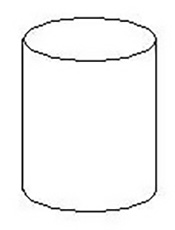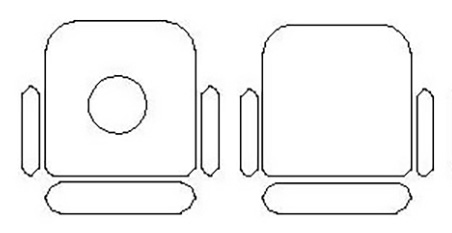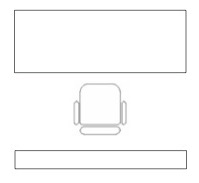The following layout, along with the list of equipment and articles necessary for a standard ORP (i.e. that only provides oral treatment during the day) to function, are only given as an example and must always be adapted according to the context.
12.1 Layout of facility and installations

Note: if the ORP is set up within the grounds of a health facility, put up a fence (posts + barrier netting or reed screens (or similar) depending on the context) to isolate the unit. One entry/exit point for patients and staff is sufficient.
| Symbols | Installations | Remarks |
|---|---|---|
 |
Potable water point |
A jerrycan or bucket or container with a tap, placed on a stand. |
 |
ORS point |
A jerrycan or bucket or container with a tap, placed on a stand. |
 |
Potable water reserve |
A 120 litre container with a tap, placed on a stand. |
 |
Latrines |
2 latrines (men/women), adjust if insufficient (at least one latrine in a PRO). |
 |
Hand-washing point(s) |
At least one hand-washing point with 0.05% chlorine solution (120 litre container with a tap, placed on a stand + bucket under the tap to collect wastewater, to be regularly emptied). |
 |
Dish washing area |
If using basins, build an apron slab to drain wastewater. |
 |
Waste pit |
A waste pit, protected by a fence to limit access. |
 |
Stock of chlorine solutions |
A jerrycan or bucket with a tap, placed on a stand, for 0.2% and 2% chlorine solutions (out of patients’ reach). |
 |
Chairs for patients and attendants |
One cholera (pierced) chair per patient. |
 |
Nurse’s post | A table, chair and shelf. |
12.2. Supplies and equipment
| Basic equipment | Remarks |
|---|---|
| Tent |
A 27.5 m2 tent for 11 patients + 1 nursing post |
| Plastic sheeting |
To cover the ground (if the ground is not smooth, washable, concrete). |
|
Wooden stands for containers |
Jerrycans, containers or buckets with a tap must not be placed on the ground. |
|
Table + chair + shelves |
Drugs and supplies must not be stored all mixed up (difficult to find and inventory) or placed in a box on the floor. |
|
Chairs for cholera patients
aCitation a.Pierced chairs are enough in a standard ORP. Nevertheless it may be useful to have 1 or 2 cholera beds if possible, for patients who need to lie down even if they do not present serious diarrhoea (elderly patients, pregnant women, etc.). |
Number depends on the ORP’s capacity. |
| Chairs for attendants | Number depends on the ORP’s capacity (one attendant per patient). |
| Buckets bCitation b.The buckets should be different colours to differentiate contents and use (e.g. white for chlorine solutions, red for patient excreta, green or blue for ORS, etc.). The designated use (ORS, chlorine solution and %, patients) should always be marked on the bucket (or any container). |
|
|
Jerrycans, buckets or containers with tap bCitation b.The buckets should be different colours to differentiate contents and use (e.g. white for chlorine solutions, red for patient excreta, green or blue for ORS, etc.). The designated use (ORS, chlorine solution and %, patients) should always be marked on the bucket (or any container). |
|
|
Recipients for covered storage + tap |
|
| Basins | To wash cups and spoons. |
| 1 litre measuring glass | To prepare ORS. |
| Cups/small spoons |
Number of cups depending on the ORP’s capacity. |
|
Personal Protective |
|
| Cleaning equipment | Broom, floor cloth, detergent, etc. |
| Communication | Mobile phone + credit or VHF radio |
| Other |
|
|
Documents and record keeping |
|
|
ORS, sachet for 1 litre |
Depending on the expected number of cases and/or consumption + buffer stock (15%
dCitation d.The buffer stock (15%) needed is less than in a CTC or CTU given that the number of sachets of ORS/person (10) is probably higher than actual consumption as the ORP, in theory, receives mostly patients following Plan A.
). |
| Antibiotic | Depending on the expected number of cases (+ buffer stock 15%) |
| Zinc sulfate | 1 blister of 10 tab/patient under 5 years (+ buffer stock 15%) |
| Soap | One per patient + soap for the staff |
|
Chlorine-releasing compound |
NaDCC or HTH (start with 50 g/patient/day, and later readjust according to consumption). |
|
Disposable examination gloves |
If the patient has soiled him/herself and needs to be changed by staff or if risk of accidental exposure to blood or carrying out stool tests or cut or lesion on hands. |
- (a)Pierced chairs are enough in a standard ORP. Nevertheless it may be useful to have 1 or 2 cholera beds if possible, for patients who need to lie down even if they do not present serious diarrhoea (elderly patients, pregnant women, etc.).
If the ORP is intended to stabilise severe cases before transfer it must have 1 or 2 cholera beds (depending on needs) + means to hang infusion sets along with the necessary materials (RL, infusion sets, catheters, 10% polyvidone iodine, compresses/cotton wool, tourniquet, plasters, tray, sharps containers). - (b)The buckets should be different colours to differentiate contents and use (e.g. white for chlorine solutions, red for patient excreta, green or blue for ORS, etc.). The designated use (ORS, chlorine solution and %, patients) should always be marked on the bucket (or any container).
- (c)Buckets for stools/vomit and waste bins must be cleaned/rinsed and disinfected when they are emptied. Taking into account the turnover of material, double the number of buckets for organic and inorganic waste.
- (d)The buffer stock (15%) needed is less than in a CTC or CTU given that the number of sachets of ORS/person (10) is probably higher than actual consumption as the ORP, in theory, receives mostly patients following Plan A.